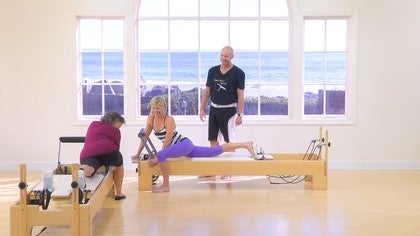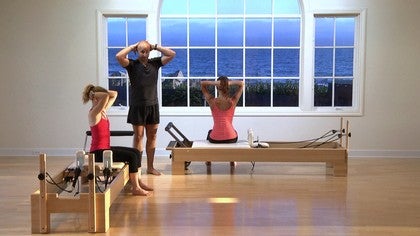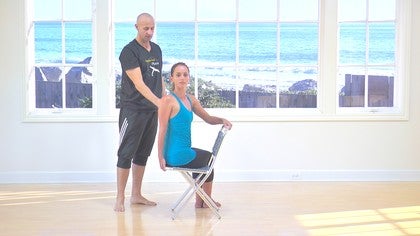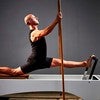Description
You also can try Anthony's Stretches for Golf and Stretches for Tennis classes.
About This Video
Transcript
Read Full Transcript
Hi everyone. I'm Anthony [inaudible] from Australia. Happy to be back here again at is any time the class that, um, we're going to film now is, is designed for office workers. So we're trying to simulate the office environment by just using a chair as much as we can, um, and not too much equipment. One of the things that Joseph Politesse did say was that he wanted to spread his doctrines on the subject of tension and relaxation. And I guess I feel as though the tension aspect of piles as well developed but not so much the relaxation aspect.
So that's what we're going to look at today and a lot of the modern diseases or the diseases of modern day western world communities, uh, related to too much tension in the body. So hopefully this class will help you to learn to relax your mind and body a little more during the day and at the end of a working day. So what we might do with Meredith is we're going to start off, um, working from the neck down. So we're going to do a few stretches for the neck, couples for the chest. Then some side bending and turning and some back bending. And also a couple of stretches for your hips.
So why don't we start Meredith with just some stretches for the small muscles at the back, the right at the top of the neck or down just here. Just below I'll turn around. So you can see this area here called the suboccipital region, which many people are tied in specially if you sit with your head tilted back this way, looking at a screen. So what we might do Meredith, if you put your fingers together and put them on the back of your head. Yeah. So first of all we'll start off with taking your chin down towards your chest and then relax your arms as much as you like will take is much wider as you like onto the back of your head. That's the first position.
See if you can relax the shoulders and you feeling stretched in the back of the neck. Yeah. Okay. So we'll just hold that position for five or so breaths. Try and settling. Try not to move too much. See if you can let your whole body relax as much as possible. Now we'll do a light contraction. So Meredith's going to press her head back into her hands without actually moving it and without using too much force. So let's do that now.
I said press back into your hands. One just for three, two, three, take a breath in. And then as you breathe out, see if you can let your arms relax a little more and pull down on your head just to fraction. How's that feeling? It's hard to speak when you heads down like that, but hopefully you're feeling a nice stretch. Now we're going to focus it on either side of the muscles there. So if you just turn your face just a tiny bit to the right and then press down on your head with the right hand a little more.
Can you feel that more now on the right side? Yep. So I'll turn around so you can see where here we've turned a little bit pressing with the right hand. Let's turn the other way. Now. Always go very slowly when you're doing these stretches. So we're just turning your face towards the left leg and then we're going to press down on the head with the left hand and hold.
Good. So when you're doing these at home, you can hold them for as long as you like. Normally five to 10 breaths for the neck is enough for most people. If you come back to the center and then just take your hands, leave your head where it is, just put your hands onto your forehead and then use your hands to lift yourself up out of the stretch. Okay. How's it? No. Okay. Let's do one more for the muscles that run up the side and back of the neck and attached to your scapula.
So we're talking about the Trapezius and Luvata scapular muscles. If, if you just sit forward a little on the, so sit up towards the front of the chair. Yep. And then put your left hand rant and Hook it underneath the back there. Yeah, so that's the anchor, the shoulder blade. Now what we're going to do is lean directly away from that hand and you'll see that the shoulder blade is as you lay in the shoulder blade is drawn down.
So now we're anchoring all the attachments of the muscles at this end. Now what we do is take your chin towards your chest and then reach their hand up to about here. Thank you. Chin down, and your head across towards this armpit. How's that? Okay, so that looks good for first position. You just gotta make sure that you keep sitting up tall. Let's hold that.
And even though there's some tension in the arm here to hold joint position, try and let the rest of your body, the shoulders and the head go limp as much as you can. So we're going to contract. So this time push your head again back into my hand or into your hand. One,
And you might if you wanted with your fingers, try just pulling on your scalp a little, just that will intensify the stretch a little more as well. There's a lot of small muscles there in the back of the neck. So what you can do is explore the stretch. Maybe you could try turning your face further towards the RMP or away from it. And when you've had enough, just take your hand off your head, take your head back towards the center of your chest, and then you can use that other hand again if you want to lift your head up.
Depends how heavy your head is. Okay, let's try the other side. Say Lean away from that hand first. Yup. Then take your Chin down towards the center of the chest. Raise the other hand up and then take your head across. So when you're taking it, you hit a cross. Make sure it stays flexed. Say Chin staying towards the chest, and then you take your head across and the stretch can be, you can see Meredith muscles being stretched here anywhere around this region.
So we'll try a contraction. So push your head back into my hand or your hand. One,
It's probably three or 30% of what you might, you know, maximum might be. And now again, you can pull on the scalp a bit with your fingers. Don't pull too hard or you might, you might pull your hair out. That's what happened to me, man. I used to have the same hair as you before the, before I did this stretch.
Turn your face a little bit more towards that way.
When you've had enough, just come back to the center to take your head back to the middle and then just lift your head up and relax these shoulder.
So what you need to do first is pull your shoulder blade back. Yup. Go. So think of pulling the shoulder blade back towards your spine. And then maybe if you turn around, I'll show you. I'll show people what I'm talking about. You pull the shoulder back and then I'm going to put my hand here.
So hold the shoulder in position. Okay, I'm going to prevent it from moving. So let's go back this way again. So I'm going to hold that in position. And then the other hand, I'm going to hold the front of your shoulder. Okay. Now what you need to do is just turn away from turn towards the left, the heart. So turn your whole body. Yeah, good. Are you feeling that way or Beth? Yeah. Yeah. Good. So I'm holding Meredith with straight arms because that way I won't fatigue and I'll be able to hold her, you know, in a secure way.
So let's do a contraction. So push the front of your shoulder into my fingers. One, two, three, four. Well overhauled, it'd be longer the contraction because we're stretching and bigger muscle groups. Now relax. Take a breath in and see if he can turn a bit further from me. Go ahead. How is that? It doesn't feel very tight, but you're getting a stretch.
If you lean your body weight just above this thumb
So it's really turn your whole forearm around and then what you do, it's just try not to be confused here. So you're trying to turn the forum that way. And then what you try and do is turn your up around the other way. So you're turning your bicep outwards and then you should feel a stretch down here. Yeah. Good. Okay. So again, we hold that. Try and keep the shoulders down and then we'll contract by putting your hand the hand that you're stretching into the front one. So one, two, three, relax.
See if you can turn it out a bit more. Yup. Turn your fingers out and your upper arm air. Good. Are you feeling that through here? Yeah. Good. And again, hold for about 10 breaths. Okay, let's try the other one. The other side.
Give it a shake if you want. There's a very useful for things like carpal tunnel syndrome too, which are pretty common in the workplace. So other one, I'm out in front
Just turn your head yeah further. And then turn your arm out further as well. And then good luck. You can, you might be out of here, Meredith. Breathing deeply, trying to relax, which is good. The deeply that you breathe, the more that you'll be able to relax. And the opposite is also true. The more shallow you're breathing, the more tense you become.
So sit up tall. The raising that we're doing that is that when you bend to the side, we're going to try and keep this hip down because if it lifts, you won't get much of a stretch. Okay? So holding that position, this is if you're on your own, it's probably more important because there's no one to assist and hold you down. Reach the arm up and then start leaning across to the side. Because I'm here, I'm going to help by holding your hip down. So you just laying to wherever it is that feels good
And if you are helping someone, you notice that I'm doing it with my arms straight so that it's secure and I like it too tired. Now let's contract them at, as I push back into this hand as if you're sitting back to the middle and one, two, three, four, five, stop breathing as you breathe out a little further. Good. That was a big great straight, good. Now once you're in this position, you can vary it. Are you okay there? You can vary it by rolling the shoulder back a little.
Remember you don't need to use too much force for five stop breathing. And let me just hold the hip down. Good. Now we'll go a bit further.
Then roll for the other way just a bit all day and then you can continue and roll out of the stretch.
You need to sit so that your legs are like this so that the um, the, the chair itself will pro pre prevent you from twisting through the lumbar spine. But then you reach around with this hand and this one and use your arms to take you into the stretch. Okay. Alright. So if you do that and then I'll assist you a little.
So this hand is going to be pulling in this direction and that's going to bring the shoulder around. Good. Just lift your chest and make sure you're sitting up tall. So this, all of this, but the upper back is rotated, not just one or two joints. How's that feel? Good. Okay, so that's a nice rotation for the [inaudible]. A sick area. I could, if you've got someone to help you, they can assist by just by adding to the rotation. I'm going to push a bit this way. Pull a bit this way.
Deep breathing here, you can say if you stay there a bit longer, Meredith, you can say, imagine her abdominal muscles are the same as the craziness single that they're wrapping all the way around the waist. So they're being stretched and by expanding them through breathing, you'll get a better and stronger straight through that region. Okay. You want to come out of there? Okay, let's try. Yeah, we'll try the other side. I'm just walking around in circles back to where I was.
Okay, so this ends here. This one's there. And then pull with his hand and push it a little with that one.
They just make sure people tend to lean back or forward or flex through part of the trunk. Just keep it all good. Now I'll hold you. Do you want me to twist you any further? Yeah. Okay. So we'll contract. So try and twist back to the star. One, two, three, four, five. Big Breath in. Lift the chest. Good. And then we'll grab it further. Okay. There. So you hold that. I'll just just wanted to remind people, if you're on your own here, pull the shoulder blades together and hold them like that because by doing that, the pic minor muscles will assist in some deeper breathing by being able to lift the chest.
The first one is just sitting towards the front of the chair. We're going to lean your trunk towards your food and then move, vary by pulling Una towards your armpit. So they feel quite different. So it's good for, for all of you to try both of them. I want to try that. So just sit towards the front. Yeah. Fall one foot across. Whoop. Yeah. Good. Now some people, if they're tired, they'll already be slumped backwards. That's okay. If that's the best you can do, then it, then just hold that.
But if you're able to lift until your pelvis forward, good. You're getting any stretch yet. Okay. So we're going to hold that position and let's say let's do a contraction now. So just push your ankle down into the leg. So one, two, three, that's enough. Take a breath in. And now let's see if he can lean the center of your chest over towards the foot and make sure you're not just flexing through the upper back, but it's actually the lane is to try and get you out pelvis to rotate forward if you can just do it incorrectly so people can see. Yeah.
So you know how you see people with their head right down like this. That's actually not what we're looking for. We're looking for that movement by lifting the chest and leaning from the hips.
So get your elbow so it's right around this way. Yep. Lift the chest. Good. And then pull this knee towards your armpit. That should feel a bit different. Does it? Good. So she's in a nice position. They're upright and with the knee coming back.
So let's do the contraction. Push your leg away. One, two, three, take a breath in and then pull back a little more. It doesn't matter quite so much how much you rotate through the upper back. It's more a matter of getting the neigh towards the armpit and trying not to let your pelvis roll back.
Good.
Good. Now relax. And then re stretch. Good. Let's see if you can tilt the pelvis a little more. Yep. So we hauled again for 10 to 15 breaths. Let's try the variation, Meredith. So if you come out of that a little, and then this time, reach your right arm around. Good.
Before you pull the knee back, let's get into, let's just make sure you've, you've got your pelvis as neutral as possible. If you pull the knee back, this so much tension on the muscles, it's hard then to adjust. So better to haul this rage around, then pull it back as much as you can, maintaining that pelvic position. And
Good. How's that?
So I'll just get the Bosu and bring it over and um, we'll try just lying back over that. Okay. So we put, maybe we put it where the chair is and if you're okay to sit on the floor, if you can sit here facing that way. Yep. Just let's have that. Yeah, that's right. Now if you can like use your arms and just low yourself back over it, the bus is usually quite a nice shape that supports your head and neck allows you to relax there. You okay? They're good. I'm just going to get a a stick and if you want to take your arms overhead, I'll give you a bit of a stretch. So I hang onto this and you let me know what I'm going to do is link back and pull on your arms a little.
One,
If your boss happens to walk in and you're doing this in your office, well I'd suggest, did you say to them is that most people, once I've stretched and taken a bit of a risk, they're actually usually more productive. So that could be a justification. If you to come out of this stretch, just put your hands behind your head and let's say if you can lift your head a little and then just roll to one side. Good. Okay, good. So that's probably enough, I think for, for a quick break at work, it's better than having a smoker and a, it'll do a lot more for you. Okay. Hope you enjoyed it. Thanks.
Feel the Length: Innovations in Pilates
Comments
You need to be a subscriber to post a comment.
Please Log In or Create an Account to start your free trial.



















